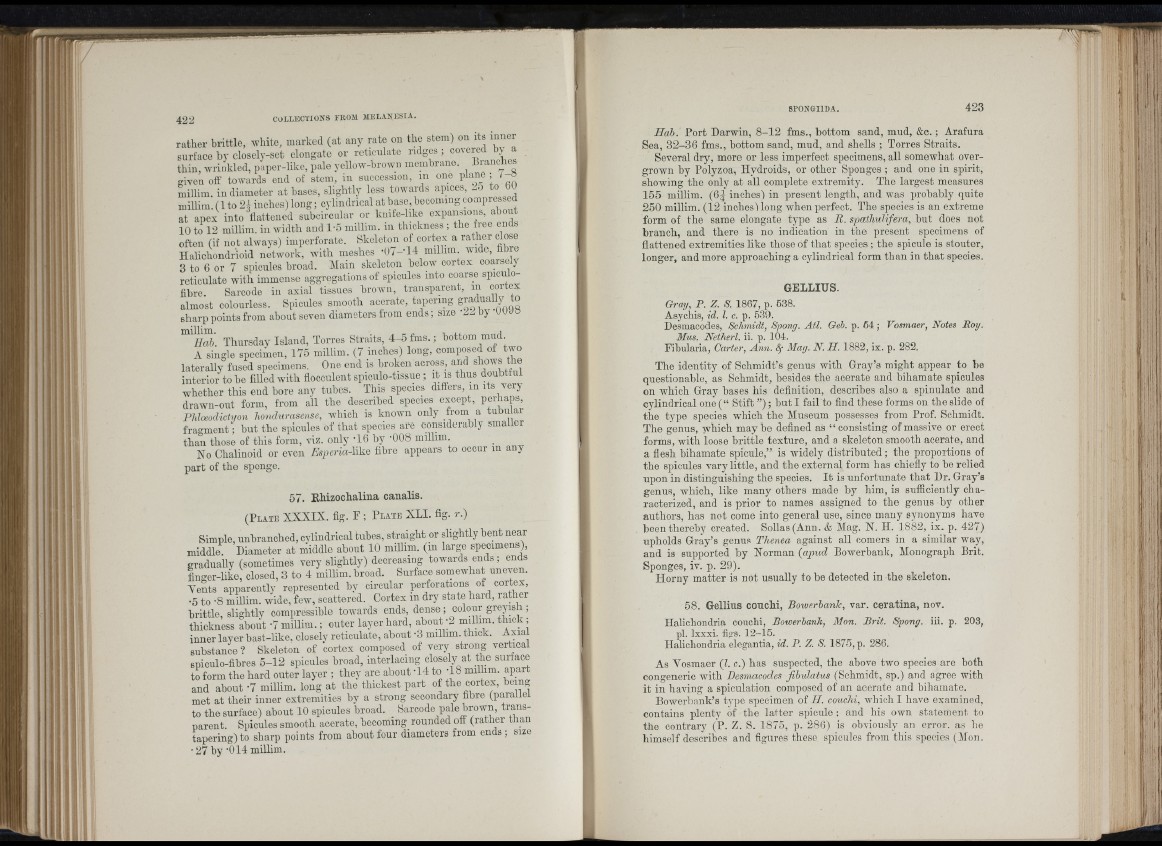
i l a '
i!l
rather brittle, white, marked (at any rate on the stem) on its inner
surface by closely-set elongate or reticulate n d g e s ; ^ ^
thin, wrinkled, paper-like, pale yellow-brown membrano. Bianch/s
given off towards end of stem, in succession, in one plane »
millim. in diameter at bases, slightly less towards apices, 2o to 60
millim. (1 to 2 j inches) long; cylindrical at base, becoming
at apes into flattened subcircular or kuile-hke expai/ions, ah
10 to 12 millim. in width and 1-5 millim. in thickness ; the free ends
often (if not always) imperforate. Skeleton of cortex a rather close
Halichondrioid network, with meshes -0/--14 millim wide, iibi
3 to 6 or 7 spicules broad. Main skeleton below cortex coarsely
reticulate with immense aggregations of spicules into coarse
fihre. Sarcode in axial tissues hrowii, transparent, in cortex
almost colourless. Spicules smooth acerate, tapering ^
sharp points from about seven diameters from ends; size -22 by -UU JO
Thursday Island, Torres Straits, 4 - 5 fms.; bottom mud
A single specimen, 175 millim. (7 inches) long, composed of two
laterally fused specimens. One end is broken acro/_, and s ^ s the
interior to he filled with flocculent spiculo-tissue; it is thus doubtful
whether this end bore any tubes. This species differs, in its verj
drawn-out form, from all the described species except, perhaps,
FMceodictyon hondurasense, which is known only from a tubn ar
fragm en t; but the spicules of that species are considerably smaller
than those of this form, viz. only -16 by -008 millim.
No Chalinoid or even Esperia-\\ke fibre appears to occur in any
p art of the sponge.
57. Rhizochalina canalis.
( P l a t e XXXIX. f ig . F ; P l a t e XLI. fig . r . )
Simple, unhranched, cylindrical tubes, straight or slightly bent near
middle: Diameter at middle about 10 millim. (in large specimens),
gradually (sometimes very slightly) decreasing towards en d s; ends
finger-like, closed, 3 to 4 millim. broad. Surface somewhat uneven.
Yents apparently represented by circular perforations of cortex,
•5 to -8 millim. wide, few, scattered. Cortex in dry state hard, rather
brittle, slightly compressible towards ends, dense; colour g r^'ish ;
thickness about -7 millim.; outor layer hard, about ;2 milhm. thick
inner layer hast-like. closely reticulate, about -3 millim. thick. Axial
substance ? Skeleton of cortex composed of very strong vertical
spiculo-fibres 5 -12 spicules broad, interlacing closely at the surface
to form the hard outer layer ; they are about -14 to 4 8 millim. apart
and about -7 millim. long a t the thickest part of the cortex, being
met at their inner extremities by a strong secondary fibre (parallel
to the surface) about 10 spicules broad. Sarcode pale brown, transparent
Spicules smooth acerate, becoming rounded off (rather than
tapering) to sharp points from about four diameters from ends; sue
• 27 by •014 miUim.
Hah. Port Darwin, 8 -12 fms., bottom sand, mud, &c. ; Arafura
Sea, 32-36 fms., bottom sand, mud, and shells ; Torres Straits.
Several dry, more or less imperfect specimens, all somewhat overgrown
by Polyzoa, Hydroids, or other Sponges ; and one in spirit,
showing the only at all complete extremity. The largest measures
155 millim. ( 6 | inches) in present length, and was probably quite
250 millim. (12 inches) long when perfect. The species is an extreme
form of the same elongate type as R . spathulifera, but does uot
branch, and there is no indication in the present specimens of
flattened extremities like those of th at species ; the spicule is stouter,
longer, and more approaching a cylindrical form than in th at species.
fp!
IP i
iUl
iii:! I■.!
GELLIUS.
Gray, P. Z. S. 1867, p. 638.
Asychis, id. I. c. p. 539.
Desmacodes, Schmidt, Spong. Atl. Geh. p. 54; Vosmaer, Notes Roy.
Mus. Netherl. ii. p. 104.
Fibularia, Carter, Ann. May. N. H. 1882, ix. p. 282.
The identity of Schmidt’s genus with Gray’s might appear to be
questionable, as Schmidt, besides the acerate and bihamate spicules
on which Gray bases his definition, describes also a spinulate and
cylindrical one (“ Stift ”); but I fail to find these forms on the slide of
the type species which the Museum possesses from Prof. Schmidt.
The genus, which may be defined as “ consisting of massive or erect
forms, with loose brittle texture, and a skeleton smooth acerate, and
a flesh bihamate spicule,” is widely distrib u ted ; the proportions of
the spicules vary little, and the external form has chiefly to be relied
upon in distinguishing the species. I t is unfortunate that Dr. Gray’s
genus, which, like many others made by him, is sufiiciently characterized,
and is prior to names assigned to the genus by other
authors, has not come into general use, since many synonyms have
been thereby created. Solías (Ann. & Mag. N. H. 1882, ix. p. 427)
upholds Gray’s genus Thenea against all comers in a similar way,
and is supported by Norman {apud Bowerbank, Monograph Brit.
Sponges, iv. p. 29).
Horny matter is not usually to he detected in the skeleton.
58. Gellius couchi, BowerhanJc, var. ceratina, nov.
Halichondria couchi, Bowerhank, Mon. Brit. Spong. iii. p. 203,
pi. Ixxxi. fips. 12-15.
Halichondria elegantia, id. P. Z. S. 1875, p. 286.
As Yosmaer (Z. c.) has suspected, the above two species are both
congeneric with Desmacodes fihulatus (Schmidt, sp.) and agree with
it in having a spiculation composed of an acerate and bihamate.
Bowerhank’s type specimen of H. couchi, which I have examined,
contains plenty of the latter spicule ; and his own statement to
the contrary (P. Z. S. 1875, p. 286) is obviously an error, as he
h im s e l f describes and figures these spicules from this species (Mon.
:r.■ ir